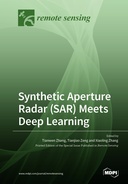Explore

Synthetic Aperture Radar (SAR) Meets Deep Learning
0 Ungluers have
Faved this Work
Login to Fave
This reprint focuses on the application of the combination of synthetic aperture radars and depth learning technology. It aims to further promote the development of SAR image intelligent interpretation technology. A synthetic aperture radar (SAR) is an important active microwave imaging sensor, whose all-day and all-weather working capacity give it an important place in the remote sensing community. Since the United States launched the first SAR satellite, SAR has received much attention in the remote sensing community, e.g., in geological exploration, topographic mapping, disaster forecast, and traffic monitoring. It is valuable and meaningful, therefore, to study SAR-based remote sensing applications. In recent years, deep learning represented by convolution neural networks has promoted significant progress in the computer vision community, e.g., in face recognition, the driverless field and Internet of things (IoT). Deep learning can enable computational models with multiple processing layers to learn data representations with multiple-level abstractions. This can greatly improve the performance of various applications. This reprint provides a platform for researchers to handle the above significant challenges and present their innovative and cutting-edge research results when applying deep learning to SAR in various manuscript types, e.g., articles, letters, reviews and technical reports.
This book is included in DOAB.
Why read this book? Have your say.
You must be logged in to comment.
Rights Information
Are you the author or publisher of this work? If so, you can claim it as yours by registering as an Unglue.it rights holder.Downloads
This work has been downloaded 81 times via unglue.it ebook links.
- 81 - pdf (CC BY) at Unglue.it.
Keywords
- anchor free
- arbitrary-oriented ship detection
- attention-weighted feature fusion
- attention-weighted feature pyramid network
- building extraction
- Computer vision
- conditional generative adversarial nets (CGANs)
- convolutional neural networks
- deep convolutional neural network
- deep learning
- despeckling
- differentiable rotational IoU algorithm
- enhanced U-Net
- GBSAR
- guided anchor Siamese network (GASN)
- heterogeneous transformation
- History of engineering & technology
- image augmentation
- image registration
- image segmentation
- interferometric synthetic aperture radar
- lightweight backbone
- lightweight self-supervised algorithm
- low-grade road extraction
- moving target tracking
- multi-scale detection
- multi-scale residual block
- multi-scale shallow block
- multiple skip-scale connections
- multiscale learning
- n/a
- object classification
- Omega-K algorithm
- on-board
- optical image
- optical images
- oriented bounding box
- phase unwrapping
- polarimetric synthetic aperture radar (PolSAR)
- position-enhanced attention
- radar image reconstruction
- Remote sensing
- ResNet18
- Rotated-SARShip dataset (RSSD)
- SAR
- SAR dataset
- SAR image
- SAR ship detection
- SAR target detection
- scene classification
- self-supervised
- semantic segmentation
- ship detection
- single-stage detector
- synthetic aperture radar
- Synthetic Aperture Radar (SAR)
- synthetic aperture radar (SAR) image
- Technology, engineering, agriculture
- Technology: general issues
- train from scratch
- transformer
- triangle distance IoU loss
- two-stage detector
- UAVSAR
- unsupervised change detection
- video synthetic aperture radar (Video-SAR)
Links
DOI: 10.3390/books978-3-0365-6383-1Editions

